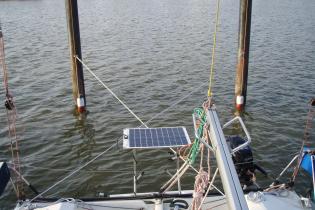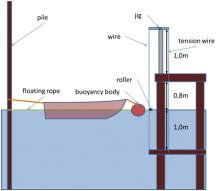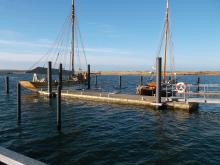
Not only land or buildings can be elevated. In Marinas also watercrafts can be allowed to adjust to fluctuations of water level. This concept shows a simple idea of how a 'flood proof mooring' system could look in a Marina in the RISC-KIT case study area in Kiel.
Based on the RISC-KIT Case Study in Kiel.
A brief description of the concept of „flood proof mooring“
This idea of concept was developed within the RSIC-KIT project and the basic approach has been used already in Marinas with higher magnitude of tidal range. However, this would be a rather new approach for Marinas in the Baltic Sea and the solution for single berths has never been tested. For the project RISC-KIT these ideas were used for the discussion of the Multi-Criteria Analysis.
The underlying assumption of this approach of risk minimization is that the variability of water level in ports and marinas cannot be significantly influenced. As a result watercrafts are subject to a permanent change in their altitude. Piers or quays, which are fixed in their height, can become a fundamental problem for watercrafts if the degree of freedom in the vertical movement is restricted.
For the RISC-KIT case study in Kiel, the Marinas are predominantly equipped with bridges which are fixed in the elevation above mean sea level. The height of the bridges is between 0.7 and 1m over mean sea level. In case of unexpected (summer) storm floods, like the summer storm in 1989, this can lead to severe damages.
Objective of the measure
The idea of such a system is to compensate the natural variability of water levels at berths for boats / ships by installing a connection to the bridge / land, which is flexible in vertical direction. With this construction the moorings are not loaded by buoyancy / gravity forces during water level changes.
Solutions
- Floating bridges/Pontoons: Such constructions have become standard in waters with regular fluctuations in the water level (e.g. waters with tidal movements). They consist of a load-bearing platform which is provided with buoyancy elements and is either moored on several piles leaving the freedom in vertical movement or is anchored in the harbor bottom at several points. Those constructions are produced already industrially, but can also be built in-house. The conversion of an entire marina may require a considerable effort during a short period (a few thousand Euro / berth) and has to be implemented in units of bridges. Therefore this approach is generally only appropriate during reconstruction / expansion of the infrastructure.
- Solutions for single berths: On the existing bridge, a mooring device is installed for each berth where the mooring can be realized such that the moorings are guided up and down vertically with the water level. The sketch in shows the idea of such construction. The sketch is not a ready to use construction plan, but the visual expression of the idea. Constructions built solely on that sketch may or not may fulfill the needs of the real world in an individual use case.
In this sketch, the boat is not moored directly at the bridge, but at a floating body, which is moving up and down along a strong wire. The floating line to the rear pile prevents the floating body from turning around the wire and additionally serves as a mooring aid. Depending on the actually existing bridge infrastructure, other constructions are also conceivable. The construction has to be adapted to the expected variability of the water level. All construction components can be made from sustainable building materials (sea water resistant metals / plastics). The construction can be installed berth by berth.













